 Tutorial
Tutorial So you want to be a Jedi...........
If you wish to share some knowledge of the game yourself, or just comment on the contents of this tutorial below, fell free to mail me at d_eath@geocities.com .
"David Eath"
 Tutorial
Tutorial
This tutorial is written with experience mainly from FPSPRO96. However it is valid to later versions as well (97-98).
For Start
I hope this tutorial will help you to get better (and learn how to learn to get better) and by that increase the competition level in the leagues you participate. Nothing is more boring than 16-0 or 15-1 records.
Always put 5 men in MTM coverage, IS CRAP. Many tutorial preach this and don’t listen to it, although a lot of the other stuff in those tutorials are sound.
Don’t overemphasize on ratings of players. There are a lot of tutorials on how to evaluate players and how the ratings work. Good read them and keep it in mind but it’s not the rating that makes you plays work or fail, most of the time.
How to improve
This is what I've done and it have helped me a great deal. If you have the basic knowledge of how the game works, take a league which have their PPP:s accessible (it's stealing some might say, well.........join a league with scouting allowed then). Find out which teams are the best (about 4-6 of them). Play each once with your current set of plays, or play them against each other.
Now figure out how their gameplan works. Not just a single play, but the whole game picture. A couple of guiding questions. Find out which of the team you have the most problems against (usually it's the heavy blitzing teams). Then your opponent is set. You will not play another team until you beat this one at least 2-3 times in a row (and don't take the homefield advantage either). This might mean a lot of games against the same opponent (I had about 15 the first times) but the learning process is great. This also means you have to have a profile, which is easy to edit, and I'll show you how to do one later.
Now try to find out why he is winning. There is no use in checking the rosters, they DO have importance but it will not do as an excuse, they are not that important.
DO NOT STEAL plays straight of. STEAL THE IDEA. This is not to moralize but if you wish to learn then it won't help you one bit.
The Mirror effect
This is something I’ve actually found out from a book about the cold war. I will explain using that as an example. After the cold war the US had a stronger military force than the USSR, including the nuclear bomb. However, being prepared for each other, both US and Russia started an arms race (well you all know this……but anyway it’s a build up, ok). If you where there at the time you might have got the impression that the US and Russian side where about equal and that there indeed was a "race" for military superiority. Well, it never was a race. US had the lead from the start after the WW II, and they kept pulling away (in military strength) ever since. In retrospect they usually had about twice the military force (not in man-power but ability and well…force) at any point after the war. So why did they keep spending all these money?
Apart from the pressures from the military industry and other economic concerns they where subjects to the Mirror problem. Every time the US military invented something new and improved they got the notion "If we can make this, the Russians can do it as well, and we better develop a defense for it". This kept going, and with the new defense at hand they went "If we have this defense the Russians could have it to and well better make something to beat it". So in fact the US army did have an arms race against their mirror image, never realizing the Russians where never close.
Mirror effect in football
This is very common I believe. When you start editing plays you start to train them against your own plays. Using your own offensive formations against your own defensive formations, finding out how to beat yourself. So what happens. You will find a way to attack and then find a way to defend it and go "Hmm, better change the attack cause this works bad now": Training against your own plays is USELESS.
The reason I believe it’s quite common because you often see profile which use one or two main ideas for attack. It may be a certain pass route or zone busting play. And the defense are experts at defending against that kind of attack. He will use for example the short out area for quick passes and then almost every defensive formation he has do protect that area fiercely.
"This is great this offense, hmm better defend against it"
In the long (if the team are practicing against their own plays) this style of attack will be dumped since every defense you set it against will defend against it. "Hmm, better find another way", and "ding" a new style of offense and the following new style of defense.
I wouldn’t even recommend to practice against other people’s plays in the practice simulator. In a profile there is usually included all sorts of crappy plays, that hardly is ever used in the current profile. Some defense may be designed for a very specific situation of opponent and it’s usually hard to see that by looking at a play.
Develop you plays against a few standard sets and if they are great there, put them to the test by "sim" a game against another profile.
You will see that the development of your offense and defense will be more separated than before and more in response to the other teams than your own. And since that is the ones you’ll use em against it’s for the better.
More on Scouting
When playing whole games against profile you will se patterns in you of defense and offense. Which plays beats me. In a one game test it might be pure luck, but if you sim four or five game you will see which plays are beating you regularly. Spot those plays out and see what they do. Which area they attack, if they are busting zones or what kind of routes they use. Usually you will find that they could probably be categories all in one of two categories (zone-busters, short out routs, passes over the middle, etc.) Then it’s easy to develop a defense against it. (This is also a great way to learn. You are now being more or less forced to learn how to defend that certain kind of play. This probably wouldn’t happen if you designed you own plays, since you usually already know how to beat them.)
See what sort of attack he use and also see how he defends against it (mirror). This will help you to create a defense against the attack.
If you are using the profile procedure described below it will be really easy to add and remove plays from the game plan and see how that affects the outcome of the game.
Look at key stats that you can affect. Fumbles and interceptions and so forth are almost exclusively random events. However if you get interceptions from one certain play don’t use it against this opponent, but still keep it. It might work against someone else (and if it continues to fucks up scrap it, no mercy). This goes for fumbles too.
Examples.
Look at time of possession. If you need to have the ball more add some run plays.
If you need to score more increase the "gamble" factor by adding long passes.
If he is running all over you, add some plays that are better against the run.
Can he handle your blitzes? If he can’t give him hell, go blitzing as much as you can.
If he does handle your blitzes, either decrease blitzing or design better blitzes (blitzes are in my opinion the key to defense).
The important factor here is that you don’t overdo it. Don’t exchange all your plays to defend against one certain aspect of the game, remember he might change too. Go gradually towards an acceptable level.
Offense
Wait logic for the OL
I think it's better to use a small move (0,5 yard 45 degrees towards an imaginary Nose Tackle ) for the OL. Make it small, real small. When you get the yellow square it should be almost all underneath the G. To much and you will have DL:s getting sacks and holy cow....we can't have that can we....not in this game anyway.
Blitz
The blitz is one of the most popular defensive strategies in the leagues. It's kind of hard to figure out how to beat a blitzing team if you're not fairly experience with the game. By starting out to beat the blitz you will learn the other feature as you go along, but in the end you must be able to beat the blitz or you will go down. The blitz is the only advantage the Defense have in this game and as well as you will learn how to use it I will also try to teach you how to beat it.
Beating the Blitz
There are three ways I know of to beat the blitz. Quickness of play, sweeps and 8 man blocking. We'll talk about sweeps later, and the 8 man blocking is ....well 8 men blocking. So we'll go to quickness of play.
First if you have a fast QB don't have him in shotgun. The QB will only start to read when he gets the ball and if he is fast enough (65+) he'll get the distance from the LOS almost as quickly, however he'll have the receivers in check and can stop his drop to throw.
Use short, short patterns, usually with look-for-pass within 5 yards of the LOS. I've noticed that the QB is more eager to throw the ball is a receiver have a small quirk or cut in his route rather than having a straight route.
Passing Vs Blitz
The key against a heavy blitzing team is usually in the fullback (huh?), or to specify, the player with the 5:th speed rating among your eligible receivers (we will call him the FB from now on). The reason is simple. To be able to get results from a blitz you MUST apply more that 6 players rushing. Once you've learned pass blocking you won't get caught by a blitz of less than 7 very often. So, when 7 players are applied to the blitz there is 4 to cover which leaves one out. This guy is often the slowest on your team. To make it even safer set him in the backfield and then he'll also be 2:nd SP backfield avoiding some who like to cover 1:st SP backfield.
How to pass this fellow is depending of which blitz-coverage is used. Either the 4 DB:s are going Zone (or a read-zone) or they are going M2M.
Blitz with MTM coverage.
1. Here you can be really nasty. Your FB is line up in the backfield. Now use shift-before-snap to line him up in the slot position on the TE side. Have the TE at the LOS. Now make the FB alone on his flank (i.e. if you have a receiver outside motion him to the other side). Make the QB drop short and check for the FB first. Let the FB do a little quirk or short out pattern to draw attention to him self. If this works right he'll be all alone on his side and will get a bunch of yards. This will not work against zone or read coverages.
Blitz with Read or Zone Coverage
This is equally simple and the ides is the same. You now shift the FB to the slot and make him to a short out underneath the WR whom will draw the zone with him in a fly pattern. Why the FB? Because if it's a M2M coverage he will still get the pass free. But remember now those if you want him all alone don’t use a zone-drawing WR on that side. Usually the WR fails to block the DB who's covering him and he will stuff the FB, still for a gain but not a huge one.
Blitz with a Read LOM coverage
This is a zone-coverage with a twist. By using LOM coverage the read-covering player moves with any motion (se below). This time we'll use the WR on the outside of the FB (whom we've shifted to the slot position) to draw the outside read defender out of position and thus leaving the FB alone once again.
The LOM also allows the inside read-zone guys to follow the FB out. To limit the effectiveness of this use line up in a Pro-formation and have the FB at the strong side. The Read-LOM guy will usually pick the TE and remain with him.
Apart from this short-out patterns underneath a zone drawing WR usually beats the blitz.
3rd and Long Vs Blitz
The plays mentioned earlier are fun and irritating, and also quite effective against blitz happy teams. However they are of limited use against other defensive strategies. Few coaches go blitz all the time on 3rd and 10 or 3rd and long therefore you will need another blitz beating play here. There are two proven methods that I know of.
8 Man passblocking schemes.
There are two sets of schemes here that I've seen. One where the RB:s take on the inside rush up front and one where they stay and hang around the QB to pick up the guys coming through. The difference is that if you want to bring the RB:s up to the LOS to take on inside blitzes you don't use the wait (move to) logic for the guards.
Tip.
When setting up the RB to block for pass, start them moving outwards. Why? Cause if the players covering them have Bump logic (some use that to help the blitz and some even use it as a sort of blitz) they will start moving outside to follow and won't damage the inside OL as much by "stealing" blocks.
Rollouts.
A good rollout is a killer. Rollouts are scarcely used I've noticed but those teams who have one or two usually use them quite a lot. Rollouts are good against the blitz. Almost every blitz is made to take a drop-back QB not a rollout one. When making a rollout be sure that the receivers you designate as targets have a pattern that "flows" with the rollout. Passes lateral across the field will take to much time.
I still recommend to use 8 players blocking though.
Running against the blitz
Yes, off course. Blitzes tend to be made up of Run rush aggressive and blitz logic's. Neither particularly good at stopping running plays. Now there are two ways of running against the blitz inside and outside duh!
Running inside against Blitz
The key here is Quickness (not the attribute but the speed of the play). The inside runs works better if they are fast and straight forward, not any spagethi patterns for the RB that slows him down. Have the RB start near the LOS (say 3-4 yards) and take the hand off immediately and go for a whole. This strategy emphasizes on the gamble that the DL or blitzing players usually misses a RB bursting through. These runs usually produce a gain, and the length depending on the success of the DL and blitzers. It works quite often actually. Strength is more important (to break the tackles) than speed, way more.....
Running outside
This is even better. Blitzes tend to over commit people to the center of the field and leaves the flanks open for huge gains. It's important here to, once again remember, which coverage the defense usually use to their blitzes. If he use zone you wish to have a lot of players on the flanks to block away. If he use man you don't wish to have any (i.e. all receivers and so forth on the other side).
Passing General
The art of passing. You can almost tell from the PPP if a coach is experience or not (not always but more often than not): If there is 4 running plays and 28 pass or something like that it's usually a more fresh coach. This is because it's perceived as easier to do good passing plays than running plays. And passing plays are easier to get results from in the practice simulation.
Passing plays are however, not easier than running plays. It might be even harder to have good passing plays.
Fake Pass
The Fake-Pass logic I recommend you to use in all passing plays where you have the time. There are two useful things about the fake pass.
1. It's may save you QB from a few sacks, making the defensive player jump instead of tackle the QB. This give the QB a little more time to get rid of the ball or dodge away.
2. It delays the QB:s read (i.e. when he starts looking for the receivers) of the receivers. This is good if you don't wish the pass to go away to early. Some routes benefit greatly from a short delay of the QB:s read.
Fake Hand-off
It's suppose to (I guess) to fool reading players into run coverage, or to follow the wrong ball carrier. I've never really seen this fake work in the game.
Attention to the receiver
When drawing routes for your receivers you should know that small "quirks" or change of directions makes the receiver draw the attention of the QB. Therefore it's hard to get attention for a player with a straight line route. If you want a player to get the attention at a certain point of the field and his route is otherwise a straight line, add a small, small, "quirk" (or cut), even the throw a fake logic's works here.
However this goes both way. A poorly placed "quirk" tends to make the QB throw the ball no matter what, and often into heavy coverage. For example the fly pattern below. There you only wish the flying-receiver to get the attention if he's run through his coverage and otherwise you want him pretty much out of the play. Then be sure his routes are straight lines or fine-tuned curves (no sharp angles or "quirk" in them).
Another thing that draw attention to a receiver is if he is breaking through his cover man. While breaking through he will get a little slowed down but after that his will sort shoot out from the cover man. If he have the look-for-pass logic on then he will get the attention of the QB very often. This makes routes with look-for-pass from the LOS vulnerable to bump coverage, because the passes tend to go off the mark.
Look for Pass logic
First a player with this logic will be less prone to get offensive holding or illegal block penalties. So any receiver who's not supposed to catch the ball should have the look for pass anyway otherwise he might get naughty.
Where in a route you put the Look for Pass logic makes all the difference in the world, regarding the route effectiveness.
Look for pass in the "Cut"
This is the most common placement of the Look for pass. It's located exactly at the point where the player change direction.
Look for pass Before the Cut
Here you must be careful so that the cut is not to sharp. If it's to sharp the QB will overestimate the receivers speed and throw the ball out of reach (interceptions!) of the receiver. If you apply a 90 degree cut while looking for pass (like a dig or out with 90 degree angle) the receiver will usually get the ball in the cut (i.e. just turn around and catch the ball). Sharper than 90 degree cuts with this logic is absolutely not recommended.
Look for pass after the Cut
Here the cut is made before the look for pass logic. How effective the receivers cut becomes in this case I think depends on the receivers intelligence. With a logic box present the chance of "cheating" with the route is less, but if there is no logic box beware that the receiver might invent his own version of the route (often less effective).
Areas of Attack
There are basically 5 areas to attack with a pass. These areas are: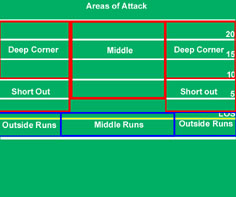
The Deep corner (L/R)
The short out (L/R)
The Middle
You can divide the field in more if you wish, (I have certainly done so myself in the past) but I think it’s of limited use, or overkill if you so like.
A good passing play attacks: A the weak area of the defense (found out by scouting) B: More than one area. I’d dare to say that it’s impossible to have the defense covering all areas without having zero pressure, and even so there will be a weak link within either in some area or by the type of coverage he use (se below).
If you are playing an opponent you will soon find out where his defense is weak, for example in the Deep corner area. Then use plays with at least one post-corner route in many of your plays. This will force the defense to be able to adjust and cover that area.
The routs
It's amazing how complicated routs some people use to get of a pass. There are basically 5 routs you can use (god damn it! NO MORE ever, never, ever.......just kidding).
The Cutback route (varying Depth)
The Fly route (post or flag)
The Out rout (Deep or short)
The Dig route (Varying Depth)
The Post corner route
Picture: Different routs. (Var.)= Variation of basic route.
The reasons I use only these five are that they all attack different forms of MTM coverage. We'll talk about zone later.
The Cutback route
The Cutback is usually a straight line of the LOS and however deep you want it and then a cutback.
This pattern is very good at beating ordinary and shade deep coverage. No DB alive has the quickness to catch up and the WR is moving backwards towards the ball and that makes up for an almost 100% catch probability.
It does not work against the "sort-of-shade-under-coverage" I am to display to you later and it's may also be stopped by clever 2 and 3 deep zones that makes the coverage man remain underneath the WR.
Don't have a look for pass logic before the cut, then the QB will throw the ball all over the place and usually short.
The Fly-route
This is the most underestimated route of all. This is a pure straight line with a look for pass 4-5 yards of the line of scrimmage. If a coverage man has bump or any sort of wait logic they will get burned badly and you will have about 20-30 yards. Why the look for pass 4-5 yards of the LOS and not at the LOS? First this route is made for long gains. Second, if the receiver have Look for pass at the LOS and gets bumped (and break trough, he will usually get the pass no matter what zone or cover deep MTM coverage that's ahead of him. This may cause interceptions to go up. This does not work against deep zones or reads (however it works better against deep zones than reads if you’re sort of go in the seams i.e. where the zones of two DB meet). IMPORTANT: If the fly receiver is not open you don't want the QB to throw him the ball. Therefore it's very important NOT to have any quirks or cuts until the WR is very deep (30+ yards) otherwise there is a big chance that the QB will recognize him as open. You only want him to have the ball is he has overtaken his DB.
The Out route
This is a classic along with the post-corner. The Out is a simple L shaped route to the outside. Usually the angle is tighter (more like a V) but the idea is the same. It works because the DB tends to cover a little to the inside and the cut then distance the WR enough for the QB to release the ball. It's also good because the WR are running sideways across the field and may gain a lot of yards after the catch. Short out routes are killers for unprepared defenses and the only good way of stopping them is to have a DB assigned to wait (0,5-0,8 so he remains and don't go upfield to cover) in the outside in a small zone.
The Dig route
This is like the out-route but it goes to the inside instead. Here a sharper angle than an L is of less use. It's to hard to fake a DB to go outside of the WR and a slighter angles makes the cut faster which is essential when you must more or less go through the DB (who covers a little to the inside). This route often targets the middle, which is an area often left unprotected. Many coaches forget about the middle because it's harder to design pass patterns directed to the middle. Use it! The dig is also good because it usually takes out double coverage, which has one underneath and one deep. Going in 90 degrees makes him get the ball between them.
The Post-Corner
This must be the oldest pattern in the FPS book. The WR goes straight cuts inside in a post (or even as much as a 90 degree cut) goes for about 5-10 yards and then release (together with a look for pass at the same moment) to a corner pattern. It's a good pattern. Shade-deep coverage and deep zones destroys it though.
Now we have the tools for a passing game.
The important thing when designing a passing play is to think about combination of route. How often do you see plays where all the receivers have the same route. What is the point of that?
If the coverage is designed to cover in a way that beats that route all three receivers are useless. Then it's better to use a combination.
For example
The Fly-Cutback combination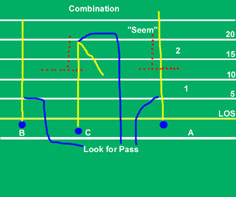
Use three receivers. Send two (WR A, WR B) on fly, one along the sideline and one in "the seem" on an imaginary 3 zone (a zone coverage splitting the field in three equally sized zones). Then have a third (WR C) receiver (possibly TE, but be careful with that (se below)) Run in the opposite seem and do a cutback to the inside. Have this receiver as No.1 because the QB will throw to an open WR A or B if they are open, but if they are No.1 he have a greater risk of forcing the ball into coverage.
OK what is this good for?
This pass beats many different coverage’s.
It beats a bump and run because then the WR A or WR B (one of them at least) will overtake their DB and have a bomb their way.
It beats ordinary coverage because the cutback beats it almost every time. Remember not to quirk the WR A and WR B.
It beat the usual defense of two deep zone-defenders that are assigned to the flanks (around the 20 yard) to prevent the post-corner and timed passes. The middle is usually free.
It might beat a 3-deep zone as well as the A receiver goes in the seem.
This play attack many areas and the best way to beat it is the blitz, since there is only 7 men blocking.
Passing Vs Zones
In Zone coverage the DB covers the DEEPEST receiver in a MTM fashion. If there is a zone behind him he will let go of his player IF, and only if the DB in the zone behind him doesn't have a player to cover all ready. If so he will stay with his player.
To pass against zone is to get at player deeper than the receiving player in the targeted zone. One player is always the "clear" player, who drags the zone coverage.
Example
Post-Corner-Dig combination to bust a zone.
The outside (A) receiver goes in a deep dig pattern, so deep that he gets into the last zone of the defense (usually defense sets up their zone no more that 20-30 yards back), lets say 20 yards. He will attract the attention of the DB (2) and then start moving inside. The DB (2) will follow.
At the same time the Post-corner guy (B) starts of. He's starting of the LOS to be a little behind. We don't want him to attract the attention of the deep zone.
If there are a two deep zone the zone player which have released the first receiver (1) to his backup (2) will now have to take on the second guy (B). Now remember that the zone work like MTM and the post-corner kills MTM.
So, when the post-corner cuts to the outside he goes underneath the dig-guy. The deep-zone DB (2) is going in the wrong direction (following A) and will usually not be able to catch up before the ball is caught by the post-corner guy.
This play works against the zone, AND the MTM coverage. Because if it's zone se above, and if it's MTM the post-corner should do the trick. Again think combination.
Another example
Fly-Post Fly-Corner X-cross
This one is even simple, however it lacks the advantage of being useful against ordinary MTM.
Send the inside receiver (who start on the LOS we want him to be the bait) in a Fly-route that cuts, lets say around the 15 yard line, and goes towards the corner flag. The second receiver lining up outside the first goes the tame way but cuts inside toward the goalposts instead.
The first guy draws the attention of the zone and make the DB pursuit him towards the corner. The second man goes underneath and up to the deep-middle area of the field. If this works TD (unless you're cursed with slow receivers).
This play does not have the combination. If you want to add a combination send a third receiver on the opposite side on a deep comeback rout. You don't want him to comeback to soon though since you want the play to develop first and have him only as a backup plan.
The key is that one player enters the zone first and is the most deep player. Any player going underneath him will be clear, at least of the zone defender.
Short pass play
There is only one reason to use short passes and that is to beat the blitz. If you're going to pass make it for real and make sure you get at least 11 yard if you try. Passes of less is only to be use in certain situations (Goalline, to beat blitz, 3rd and short or 5. What about 2nd and Short you might ask. Well.. suit yourself but there are better way to use 2nd and short which I will tell you later).
Running the Football
Running is a very tricky thing since the game is designed so that you may think you know what the OL does by the name of their logic but in fact you don't.
Blocking
This is the trickiest part of the running game. You want as many OL as possible to go downfield and take on LB:s and DB:s. What usually happens is that 3 DL manage to attract the attention from the whole line and you'll see the OL:s gang banging the DL forever and don't bother about the lesser (but equally efficient) LB:s.
To solve this you use, MOVE TO-logic (say it out loud MOVE TO!)
Test this by setting up you line in the practice simulation. Set move-to logic straight-ahead for all five of them. Then set up a defense and se what happens. Even if the OL have move-to they DO BLOCK the DL on the way (This is also true for receivers without Look-for-pass logic. That’s why they tend to get many pass-interference, they start blocking around when they don't know what to do).
Ok, same shit as before, but that’s not the case. If you study hard you'll se that if the OL doesn't have a DL charging him he will abide by his path and go ahead and start searching for blockable objects when his move is over.
By using this you will have OL helping out among the LB:s and you can also use them to set up small screens. It's hard to explain but there are some example plays that would make you understand (at least I did, since this off course is not my own invention).
Also this goes especially for the lead blocking FB if you want to use such. With a lead he will go allover the place but with a Move to he will block everything in his path and don't go astray.
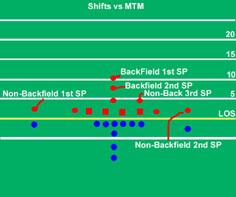 Motion and
running.
Motion and
running.
When running try to create a unbalance. Use motions and especially shift-to logic’s as much as you can.
Here again the coverage is the key. If zone try to put a lot of blocking player on one side, if MTM keep them away from the side you intend to go to.
If MTM coverage all covering players Line up on their man. Use it!
Running inside
 Learn the
blocking above. Without it you can forget the inside. When you have that covered try to
work out how to use shifts and motion to create and advantage.
Learn the
blocking above. Without it you can forget the inside. When you have that covered try to
work out how to use shifts and motion to create and advantage.
If you for example move you fastest RB out of the backfield and set him up in the slot. He will be cleared out of the middle area (where you intend to run), and that’s one less defender for your OL to take on and they can go even deeper and help you out.
Have the fast RB move to one direction and the ball carrier the other. If you're lucky the covering players will crash into each other (very unusual but it happens), if not you still have one defender going in the wrong direction of the play.
Running outside
 The Key to
running outside is long pitches. Almost every league has a rule about how to pitch. The
other thing to remember is that you want the whole defense in a pile in the middle. Make
every player work to drag players into the middle and use players to set up screens so
they'll have trouble getting sideways.
The Key to
running outside is long pitches. Almost every league has a rule about how to pitch. The
other thing to remember is that you want the whole defense in a pile in the middle. Make
every player work to drag players into the middle and use players to set up screens so
they'll have trouble getting sideways.
Timing passes
I don't use them. They are good I am told and they can do a lot of harm. They basically use the same principle. A small cut outside and there is the ball. Everyone can do a timed pass. And if you like them do. I will teach how to defend them later.
Running Vs "Cheating" Coverage
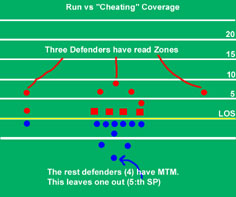
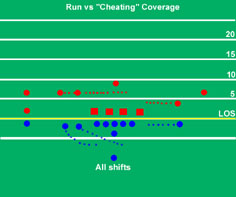
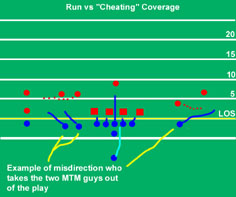
Running Vs Zone
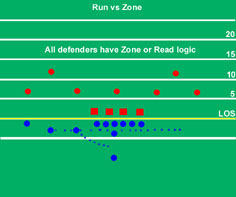
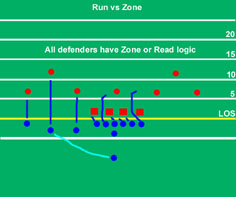
DEFENSE
Defense is about position, rhythm.............well, I once read it and thought I understood that too, but now I think it is to complicate stuff more than necessary.
Defense to me is two things. Pressure and coverage. Without pressure you can't ever defend the pass. The DB:s are not that good. And without at a coverage that upholds your pressure you can't use that either.
Ground rules
Defensive Line
Line Up wide with your DL. Preferably as wide as you can while still keeping them in a "down" position. This will have the Ends outside the Tackles, facing a TE if such is present.
Second I use two combinations for the DL logic. Either Run Rush aggressive or Read pursuit conservative.
Run Rush aggressive can get the DL "around the corner" of the OL and also helps stuffing the outside runs by shooting down into the backfield.
The read, pursuit conservative is very useful. Either the DL pass rush or they get the run rush conservative which makes them gang up towards center. It works great against inside runs.
Also another good thing is to line up the middle DL (1 or 2 DT) 2 yards back (or so far you can and still keep them in stance). Then use either Read Pursuit conservative or Run rush Conservative Pursuit conservative (important). The Read version lets the DT pass rush if there is a pass or follow the ball sideways if it's a run. The Run Rush conservative (and pursuit conservative) makes him remain steady in the middle and Key the QB (like the LB logic), following him sideways if there is a rollout. The pursuit conservative is essential here because if he have any other he might be overpursuing the QB and get burned. His job is not to sack but to take the QB at the LOS. In this case you might want the End a little closer but not inside the Guard-Tackle gap.
I have found no advantages of stacking all 3 DL tight in the middle, if you know any I would like to know but I smile every time I see my opponent use that DL lineup. The DT(s) can have a Run rush conservative logic and Ill explain why under the blitz section.
Don’t use Pass rush unless you know what purpose it will have, i.e. know what you’re doing.
Pressure
Here I could say blitz instead because it’s hard to get pressure without committing 7 or more players. Maybe 6 may do the trick to but why bother. There is more to gain from speed and severity of the attack than extra coverage. The important thing is that it’s fast.
Blitz
If you’re going to blitz you will gamble, so it’s just as good to do it properly. Assign maximum players allowed to the blitz (usually 7). The rest will be in coverage (below).
When assigning players to blitz you have two options (we are only talking non DL
players now). Either Run rush aggressive or Blitz. The difference is
that Run rush aggressive makes the player run straight downfield for a few yards before
going after the ball carrier while the blitz goes straight.
difference is
that Run rush aggressive makes the player run straight downfield for a few yards before
going after the ball carrier while the blitz goes straight.
Tip 1: Use the DT to key the QB with run rush conservative. Or use a LB, but without containment a good (strong) QB will very often escape the blitz and run for a whole world of yards.
Tip 2: Don’t just look at speed and quickness when sending blitzers. When they get there they must be able to bring the QB down as well. Therefore it’s preferable to use fast LB:s or strong DB and maybe sacrifice a little of the speed. IF you use DB:s on the outside of a blitz you can almost be certain they will get run over by sweeps. LB:s gives you a better chance there.
To explain how to do a good blitz is more difficult than you might think. I have several blitzes that almost are identical but some of them work better than others and I still can’t figure out why.
This is a blitz I use and I’ll explain it (of course the base concept is not my
original idea, either).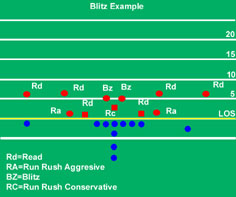
The line looks like this. DL is wide (se above) The DEs have Read + Pursuit is conservative. The DT have run rush aggressive. The two outside LB:s have run rush aggressive and the two inside players (1 LB and 1 fairly strong DB) have Blitz.
DT: The DT have Run rush conservative to act as a Key QB linebacker. He will follow the QB sideways, not going forwards towards him, across the field and nail him at the LOS. Then only six players are blitzing you might say. Technically yes. But I have the DT so close that he will keep the attention of the center throughout the play thereby reducing the blockers by one.
Outside LB: First they are LB:s because they handle outside runs better, and have a
greater chance of bringing down a sweeping RB. They have Run rush aggressive to go
straight down backfield and hopefully round the tackles (if they are slow) or at least
draw their attention from the middle area where the attack is.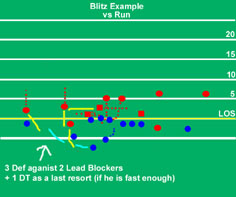
Inside Blitzers: These are place a little further back to be able to arrive just when the holes between the guards open up. Remember that while the offense have their screaming contest, calling audible, you blitzing players will advance about 2 yards forward so take that into account when you design the play.
Why all this run concern in a blitz?
I have that in this blitz because it’s a first down blitz where chances that they might run are greater. At third and long I would have the outside DE as run rush aggressive. Still keeping the DT as Run rush conservative because if the QB breaks lose he will get a first down almost every time. The DT still keeps his man occupied.
Outside or Inside?
Outside Blitzes are slower. Inside is faster. However some players have concentrated more on keeping the inside blitz away than the outside, which in many case does make it more of a sack bringer. This is ONLY is you’re coverage holds up for a longer time. On 3rd and long it should be safe to use outside blitzes because then the passing routes are longer (to ensure first down) and the time not so critical. Outside also naturally work better against outside sweeps so if a player like to start of with outside sweeps give him outside blitzes.
Inside blitzes are faster but more vulnerable to the sweeps.
Coverage General
Read Zone
Read zones are wonderful. If there is a run they react and tries to stop it and if there is a pass they work as zones. The key to read zones is to know how they work. A read zone work like this. The field is divided in 5 yard lines (as seen in the play editor) and the read zones are very dependent on those. When a player is assigned read the computer check for any other players who have a read logic WITHIN THE SAME 5 yard portion of the field (i.e. 0-5, 5-10, 10-15 etc yards of the LOS. A, B, C, D in the picture). After that the computer divides the field between these players. This means three read players at the LOS (first 5yard portion) will split the field in three equal pieces (horizontally) and four will divide in four and so forth.
After this the players set up the middle of their zone 5-10 yards back. So three read at the LOS will give three zones across the field at about 10 yards of the LOS.
BE CAREFUL, only one fraction of the player on the wrong side makes him a part of a another 5 yard chunk which divides.
Placement of reads. The read zone is behind the player so be careful how you place them. Draw (mentally only) to where the zone is set up (i.e. approx. 5-10 yards back depending on placement in the 5 yard portion (i.e. at 1 or 5 yards of the LOS) to see how they will move towards their zone. If three reading players are gathered in the middle (within the same 5 yard portion) the two outmost will move in a sharp angle outwards towards their (outside thirds of the field) zone. A route that may be useful in some cases, and useless in others.
Cover the field
Se that no player wherever he goes can go straight through your defense without being picked up by someone, for example a 5:sp receiver. This is a good basic rule. If you have only 4 guys covering MTM have at least zone or reads that cover both ends of the field so that is a lone 5:speeder won’t be all that alone all the way to the end-zone.
Use combination packages of M2M and zones (read-zones).
Coverage with Blitz
Well, when you blitz you cheat with the coverage. You have 4 man to cover 5 eligible receivers. Here scouting is a good thing.
Are your opponent using his 5:sp receiver (se beating the blitz) or not. Not many players do in fact. If so you have the option to use M2M coverage, but it’s more vulnerable to the run.
BEWARE of M2M coverage against time passes. They beat MTM almost 100% and are fast enough to avoid your blitz.
If the player is using either timed pass or 5:sp receiver then you should go with zones. I would recommend read zones (see above) where all 4 coverage guys should be within 5-10 yards of the LOS. This is not a good coverage scheme in general but usually buys enough time for the blitz to be effective.
Areas of Defense
Remember the offense a while ago, with the areas of attack. No defensive play can cover all these areas cause then the game would have been over. So here you have to scout. Have plays that emphasis on different areas of defense. Does the opponent go short flat or deep corner or middle or…..what?
Then se to that you have plays that cover up these areas. And put them in your gameplan (se profile below).
Usually an offense has a "favorite" attack area. It might be. Ex. deep corner with usually post-corner or deep out routs. Take that away from him in 75% (at least) of you defensive plays (when blitzing have it in mind when setting up zones to defend). Does he have two different areas, well take both, still usually there is a favorite area and by breaking that you have achieved a great deal.
Timed Passes
See where they go, use zones to cover them. Usually they are some form of out or fly-corner patterns so make the DB come from the outside in on the defender (by assigning for example a read zone with the DB placed at the side line (the imaginary line towards his zone give you his entrance angle).
Coverage against Cutback patterns.
First if the favorite is cutback use a lot of blitzes. Cutbacks are slow patterns. If you want to cover against them set up zones so that the guys near the LOS (not near but a zone around 10 yards of the LOS) have at least two "levels" of zones set up behind them. They will pass up on two guys who fly through (se passing Vs zone) and remain in place. Or use any other method that keeps them from picking up the Player as he goes through (in a cutback you know he’s coming back anyway so …) maybe a wait logic combined with read.
Short Out
Here is the only solution I can think of zones or wait logic that keep the player about 5 yards of the LOS in the Short out area. Have found no other way, yet (as always).
Profile Editing (an alternative Profile approach)
This is a system that is very simple to use, very adaptable and fast. Wow! All in one package. Where is the drawback. It takes about a day or two to do and it also is a little bitch when you want to add new plays but it's worth it.
Fundamental
"In order to have a good offense, you must make the defense play honest"
Gary Moeller
(Former HC of the U of Michigan)
Think about this for a moment. What is playing "honest"?
Forcing someone to play honest is to be able to overcome his favorite strategy and make him adapt. For example overcome a blitz happy team and make him have a different gameplan for your team. It is to make someone adapt to your style of play not vice-versa. This goes both for defense and offense.
The key to this approach is to be able to adapt your gameplan to a new opponent. Most of us don't have the world of time that it take to do that with the way the profile editor is designed (it's a horrible piece of junk if you ask me.........why the hell couldn't they have it in a sort of spreadsheet or something?).
So much for that idea....or?
Some bright coach said that you actually can alter the meaning of the different play type for example PSL is timed passes and RL is run outside and so forth....great...but how does that help me, really, except that it altered the way I thought about the prolife editing. Not much. Instead I've created this.
Here it is
Run Left 5 100%
Goalline Run 0 0%
Goalline Run 0 0%
2. The profile categories are named up
| Offensive Situation | Profile Call | Defensive Situation | Profile Call |
| 1st Down | RL | 1st Down | RL |
| 2:nd and 2-5 | PSL | 2:nd Down | RR |
| 2:nd and 6-10 | PSM | 3:rd and 2-10(1) | PM |
| 2:nd and Long | PSR | 3:rd And Long | PL |
| 3:rd and 2-5 | PLL | Special Defense | GLP |
| 3:rd and 6-10 | PLM | Short Yardage | GLR |
| 3:rd and Long | PLR | 2 min Defense | RZR |
| Within own 5 | GLR | ||
| Within opponent 5 | GLP | ||
| 2 min offense | RZP | ||
| "Eat Time" offense | RZR | ||
| Short Yardage | RM | Alternative Defense | |
| 1:st Down | RR | ||
| Alternative Offense | 2:nd Down | PS | |
| 3:rd and Long | RZP | ||
| 1st and 10 | RR | ||
| 2:nd and 2-5 | PML | ||
| 2:nd and 6-10 | PMM | ||
| 2:nd and Long | PMR | ||
This is the way I have my profile lined up. You might want to arrange it differently but the principle is still the same. Plays are chosen for down situations (se below).
Now create a directory called offense and one defense. In these directories put one directory for each category (come on, it is worth it, promise!)
C:\Sierra\Fbpro96\offense
- RM
- RL
- RR
- PSL
- PSM
- PSR
and so forth
Now copy all your offensive plays into each of these folder. Then sit down a while and "recategorize" them all according to the directory. So you’ll have a copy of each play saved as PSL, PSR, PSM etc in different directories (so you can keep the same name).
Why this?
Does it sound like to much work? Well try to adjust a profile in that amount of time with the same result. I don’t think that is possible, but if you know a way, good for you…………
Well what does he do on first down. He pass. Usually flat. What defensive plays do I have against that, let’s see, PASSRS04, PASSZN02 and RAMBO-06. Ok what shall I call on first down, well these three and a blitz would do the trick. Ok fill the first four spots of the gameplan with these four plays taken out of the ………… come on…………..yes, the RL directory.
Now you have your first down plays set and the above mentioned, then move on to second down and fill up you original defense.
Well, well, things do go to hell (quite often), and there are the behind 4-7 or 8+ in the profile which is an exit. The profile then shift over to your 1st Down B plays, which you have selected as an emergency. If he is beating me he is probably …….. then Ill use these plays instead (you never know and it’s a gamble).
The same goes for offense. Does he blitz. Does he cover all receivers, and so forth. When you know you also know which plays to use and it take 5 minutes to adjust your gameplan going into a game (this is off course if you have plays that handle what you want to do otherwise get working on it!)
Using this method gives you a very good flexibility and you get control over what your team does. It’s also great when trying out profiles against acquired PPP:s. See which play always screw up and replace it with another you might think work. You can increase the "gamble" percentage within a few minutes by adding a long pass at first down etc and see how it affects your results. The best part is that the play editor becomes a minor part in the game experience since most of the time you’ll be watching game to see how different defenses and offenses affect your team, and how to beat other "flavors" of play.
In the defensive gameplan there is also a "twist" which is the special category. Let’s say the player you are about to play have a lot of timed passes. You are not sure if he will use them or not. Well then you assign time-pass killer to the special category and the profile will call those for example at 1st downs within the 5-35 and second downs between the 35 and 35. Usually it’s enough to be effective.
I have submitted a spreadsheet that explains when a sample profile calls a certain kind of play. I hope you understand it. The GLP call in the middle between the 35 yard lines on defense is an A type of setup with changed 1:st down to a GLP instead of RL. This to be able to include some special opponent-specific defenses without changing the overall profile that much. He must hopefully go through this area.The empty areas under the play types are for your own "fill in" of plays to use for that situation.
A |
1st Down |
2nd Down |
3rd Down |
B |
1st Down |
2nd Down |
3rd Down |
||
0-1 |
RL |
RR |
GLP |
0-1 |
RM |
RR |
GLP |
||
2-5 |
RL |
RR |
GLR |
2-5 |
RM |
RR |
GLR |
||
6-10 |
RL |
RR |
PM |
6-10 |
RM |
RR |
PM |
||
11+ |
RL |
RR |
PL |
11+ |
RM |
RR |
PL |
||
C |
1st Down |
2nd Down |
3rd Down |
D |
1st Down |
2nd Down |
3rd Down |
||
0-1 |
RL |
PS |
GLP |
0-1 |
RM |
PS |
GLP |
||
2-5 |
RL |
PS |
GLR |
2-5 |
RM |
PS |
GLR |
||
6-10 |
RL |
PS |
PM |
6-10 |
RM |
PS |
RZP |
||
11+ |
RL |
PS |
PL |
11+ |
RM |
PS |
PL |
||
Defense |
<5 Beh 8 |
Behind 8 |
Behind 7-3 |
Tied |
Ahead 3-7 |
Ahead 8 |
|||
5 |
B |
B |
A |
A |
A |
A |
|||
6-35 |
B |
B |
A |
A |
A |
A |
|||
35-35 |
D |
GLP |
GLP |
GLP |
GLP |
A |
|||
35-6 |
D |
D |
C |
C |
C |
A |
|||
5 |
D |
D |
C |
C |
C |
A |
|||
Gameplan |
|||||||||
1st Down |
2nd Down |
3rd Down |
3rd Long |
2min Def |
3rd and 1 |
Special Def. |
|||
RL |
RM |
RR |
PS |
PM |
RZP |
PL |
RZR |
GLR |
GLR |
Offense |
|||||||||
A |
1st Down |
2nd Down |
3rd Down |
B |
1st Down |
2nd Down |
3rd Down |
||
0-1 |
RM |
RM |
RM |
RM |
RM |
RM |
|||
2-5 |
RL |
PSL |
PLL |
RR |
PSL |
PLL |
|||
6-10 |
RL |
PSM |
PLM |
RR |
PSM |
PLM |
|||
11+ |
RL |
PSR |
PLR |
RR |
PSR |
PLR |
|||
C |
1st Down |
2nd Down |
3rd Down |
D |
1st Down |
2nd Down |
3rd Down |
||
0-1 |
RM |
RM |
RM |
0-1 |
RM |
RM |
RM |
||
2-5 |
RL |
PML |
PLL |
2-5 |
RR |
PML |
PLL |
||
6-10 |
RL |
PMM |
PLM |
6-10 |
RR |
PMM |
PLM |
||
11+ |
RL |
PMR |
PLR |
11+ |
RR |
PMR |
PLR |
||
2 min Off |
Eat Time |
||||||||
RZP |
RZR |
||||||||
1st |
<5 Beh 8 |
Behind 8 |
Beh 3-6 |
Tied |
Ahd. 3-6 |
Ahead 8 |
<5 Ah 8 |
||
5 |
GLP |
GLP |
GLP |
GLP |
GLP |
GLP |
GLP |
||
6-35 |
D |
B |
B |
A |
A |
A |
A |
||
35-35 |
D |
B |
A |
A |
A |
A |
A |
||
35-6 |
D |
B |
A |
A |
A |
A |
A |
||
5 |
GLR |
GLR |
GLR |
GLR |
GLR |
GLR |
GLR |
||
2nd |
<5 Beh 8 |
Behind 8 |
Beh 3-6 |
Tied |
Ahd 3-6 |
Ahead 8 |
<5 Ah 8 |
||
5 |
GLP |
GLP |
GLP |
GLP |
GLP |
GLP |
GLP |
||
6-35 |
RZP |
D |
D |
D |
A/GLP |
RZR |
RZR |
||
35-35 |
RZP |
D |
D |
D |
A |
A |
RZR |
||
35-6 |
RZP |
D |
D |
D |
A |
A |
RZR |
||
5 |
GLR |
GLR |
GLR |
GLR |
GLR |
GLR |
GLR |
||
1st Down 10 |
Short Y. |
Def Goal |
Off Goal |
||||||
RL |
RR |
RM |
GLR |
GLP |
|||||
2nd Down 10 |
2nd Down 2-5 |
2nd Down and 11+ |
|||||||
PSM |
PMM |
PSL |
PML |
PSR |
PMR |
||||
3rd 2-5 |
3rd 10 |
3rd Long |
2min Off |
Eat Time |
|||||
PLL |
PLM |
PLR |
RZP |
RZR |
|||||
Last words on profile. Don’t use to many plays in each category. Find out the 4-5 best ones at each spot and use them. There are some leagues whom have strict rules on profile (minimum plays per category and a maximum percentage for a certain play type), and you can alter the profile to abide to at least the percentage rule without losing the advantage of using it (set the 1st Down A as max percentage and back up with 1st Down B, and then reverse it in behind 7+ and 8+ for example, or use the special category on defense).
The End